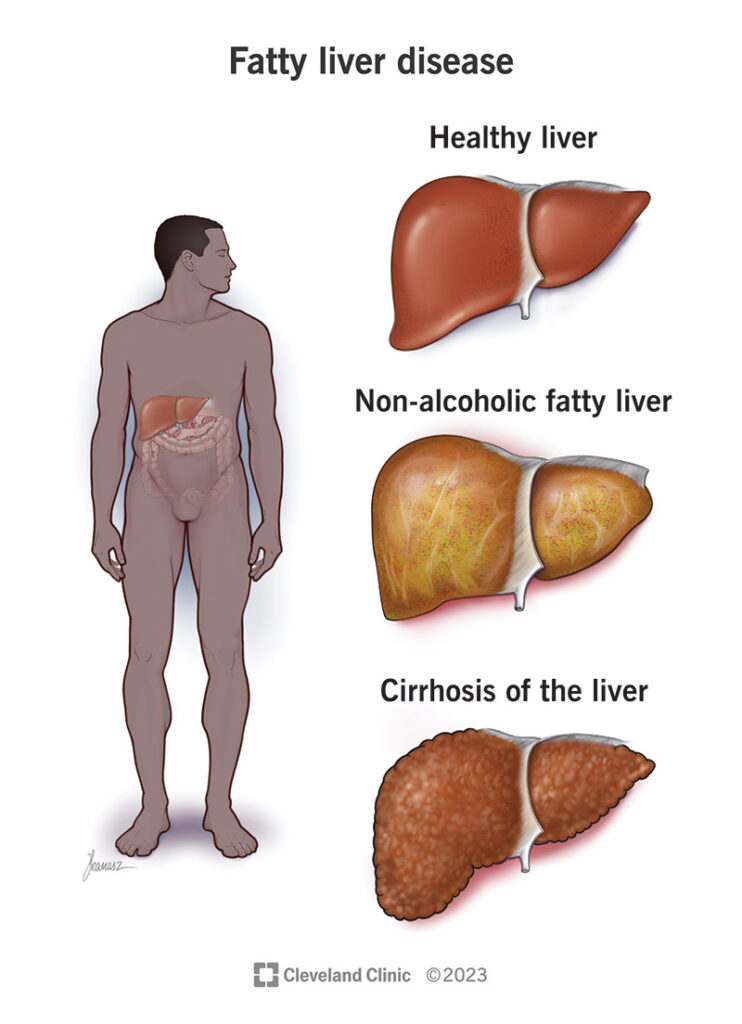Steatosis of the liver, commonly known as fatty liver disease, is a condition characterized by abnormal accumulation of triglycerides within liver cells. This infiltration of fat can impair hepatic function and, if left untreated, progress to inflammation, fibrosis, cirrhosis, and liver failure. The condition is often silent in its early stages, making timely diagnosis and intervention essential.

Classification of Hepatic Steatosis
Hepatic steatosis is primarily divided into two major categories, each with distinct etiologies and risk profiles:
1. Alcoholic Fatty Liver Disease (AFLD)
AFLD results from excessive alcohol consumption, which disrupts lipid metabolism and promotes fat deposition in hepatocytes. It represents the initial, reversible stage of alcohol-related liver disease.
2. Non-Alcoholic Fatty Liver Disease (NAFLD)
NAFLD is diagnosed when hepatic steatosis occurs in the absence of significant alcohol intake. It is closely associated with obesity, insulin resistance, dyslipidemia, and type 2 diabetes. NAFLD can progress to:
- Non-Alcoholic Steatohepatitis (NASH): Characterized by liver inflammation and damage.
- Fibrosis and Cirrhosis: Advanced stages that pose a high risk of liver failure and hepatocellular carcinoma.
Risk Factors and Contributing Conditions
Steatosis of the liver is a multifactorial condition with metabolic, environmental, and genetic determinants.
- Obesity (especially visceral)
- Type 2 Diabetes Mellitus
- Hyperlipidemia and Dyslipidemia
- Metabolic Syndrome
- Sedentary Lifestyle
- High Fructose and Processed Food Consumption
- Polycystic Ovary Syndrome (PCOS)
- Sleep Apnea and Hypothyroidism
- Certain Medications (e.g., corticosteroids, tamoxifen, methotrexate)
Clinical Features and Symptoms
In early stages, liver steatosis is often asymptomatic. As fat accumulation progresses, symptoms may appear:
- Fatigue
- Right upper quadrant discomfort
- Hepatomegaly (enlarged liver on palpation)
- Mild jaundice (in advanced stages)
- Signs of metabolic syndrome
Due to its silent nature, routine screening in high-risk individuals is vital for early detection.
Diagnostic Evaluation of Liver Steatosis
1. Laboratory Investigations
- Elevated liver enzymes (ALT > AST in NAFLD)
- Lipid profile abnormalities
- Fasting glucose and HbA1c
- Exclusion of viral hepatitis, autoimmune hepatitis, and alcohol abuse
2. Imaging Modalities
- Ultrasound: First-line, cost-effective tool for detecting liver echogenicity suggestive of fat accumulation.
- CT or MRI: More sensitive, especially for quantifying fat content.
- FibroScan (Transient Elastography): Measures liver stiffness and fat content.
3. Liver Biopsy
Gold standard for diagnosing NASH and staging fibrosis, but reserved for selected cases due to invasiveness.
Management and Treatment Strategies
There is no FDA-approved pharmacological treatment for NAFLD or NASH, making lifestyle modification the cornerstone of management.
1. Weight Reduction
- Target 7–10% weight loss to reverse steatosis and reduce inflammation
- Achieved through caloric restriction and increased physical activity
2. Dietary Intervention
- Mediterranean diet rich in polyunsaturated fats, fruits, and vegetables
- Limitation of refined carbohydrates, trans fats, and fructose
3. Exercise
- Aerobic and resistance training 3–5 times a week
- Improves insulin sensitivity and hepatic fat metabolism
4. Control of Comorbidities
- Optimize management of diabetes, hypertension, and dyslipidemia
- Statins are considered safe for cardiovascular risk reduction in NAFLD patients
5. Pharmacologic Agents (Off-label)
- Vitamin E (in non-diabetics with NASH)
- Pioglitazone (in patients with biopsy-proven NASH)
- Investigational drugs include GLP-1 agonists, SGLT2 inhibitors, and FXR agonists
Complications and Prognosis
If left unaddressed, liver steatosis may progress to:
- NASH (Non-Alcoholic Steatohepatitis)
- Fibrosis and Cirrhosis
- Portal Hypertension
- Hepatocellular Carcinoma (HCC)
- Liver failure requiring transplantation
NAFLD is now a leading cause of chronic liver disease worldwide, particularly in developed nations.
Prevention and Long-Term Monitoring
Preventive Measures
- Maintain healthy body weight
- Adopt a balanced diet
- Engage in regular physical activity
- Avoid excess alcohol
- Manage underlying metabolic disorders
Monitoring
- Annual liver function tests
- Periodic imaging or FibroScan for fibrosis progression
- Cardiovascular risk assessment
Steatosis of the liver represents a growing global health concern due to the rising prevalence of obesity and metabolic syndrome. Early identification, lifestyle modification, and multidisciplinary care are essential in halting progression to advanced liver disease. With proper management, steatosis can be reversed and long-term complications significantly reduced.

